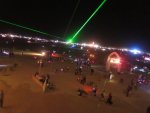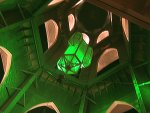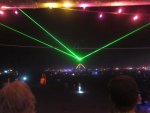Well, I've returned from BM 2011. It was awesome, and not just because of the lasers.
For the lasers, it was pretty amazing seeing beams of green and blue lasers shining over the sky such that it looked like the parallel beams were projected from two points in the horizon across a circular sky. Usually lasers are not far enough away and powerful enough to create that effect. Capturing a photo of it would have been very hard and I didn't have a wide-enough angled lens to do it.
About One Mile Clock
I was fortunate enough to meet the artists of the One Mile Clock. Jim Bowers and his team joined us for dinner at our camp. I asked them about the laser specs and the construction of the project. The lasers comprised three 1.7W 532nm green lasers each passing through a 10x Leica beam expanders in order to reduce divergence and reduce the beam power at any given point. The beams would terminate at some large hills/mountains on the horizon if they were close enough, and the spot was clearly visible from great distances (> 1 mile). The project had all the necessary variances for lasers of that power and projection use.

According to Bowers, the original plan was to use different color lasers; however, power levels, visibility and optics necessitated a change to an all-green clock hand setup. The red lasers especially would've been extremely expensive for the needed powers for good visibility, and the blues I saw on the playa just weren't all that bright compared to the green, despite having clearly visible beams across the horizon.
For the clock itself, there were green laser hour and minute hands that would turn according to the time. There was also a third fast-motion "hand" that would turn about 5-10 degrees per second. This third hand was made to give the clock greater "motion" as even at such large scales the motion of the minute hand was hard to detect and a real seconds hand would've still had boring motion.
The lasers themselves were projected upwards and reflected outwards using mirrors attached to servos in a sealed chamber. This setup prevented dust from getting into the cooling system. The real magic of the clock was in its auto-alignment and calibration system. It would literally figure out and adjust the servo's required angles needed to keep the beams aligned to the correct time on the fly, sparing the operators the need to manually calibrate the lasers.
Interaction With the Temple
The One Mile Clock also had interaction with this year's beautiful temple. At 12:00 AM (midnight hour), the hour hand would pass through the temple's center tower, striking a glass crystal hovering inside. This would bathe the chamber below in a beautiful green light. As the distance between the laser and the tower was great, this produced no eye exposure hazard.
Overall, the project itself was just one of many incredible art projects and a city of mostly wonderful people. I had a great time and would invite you to see BM yourself, laser enthusiast or not.









